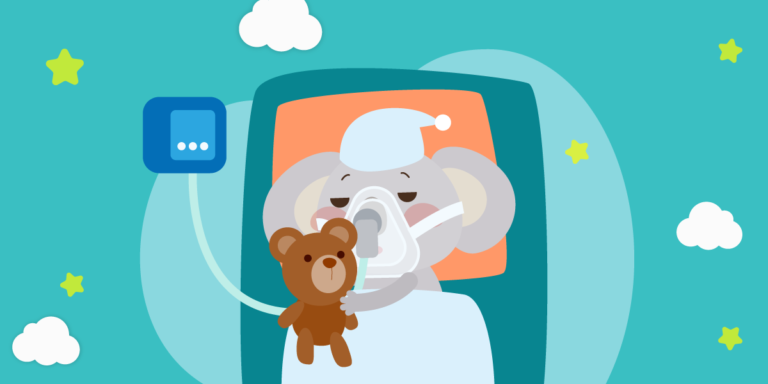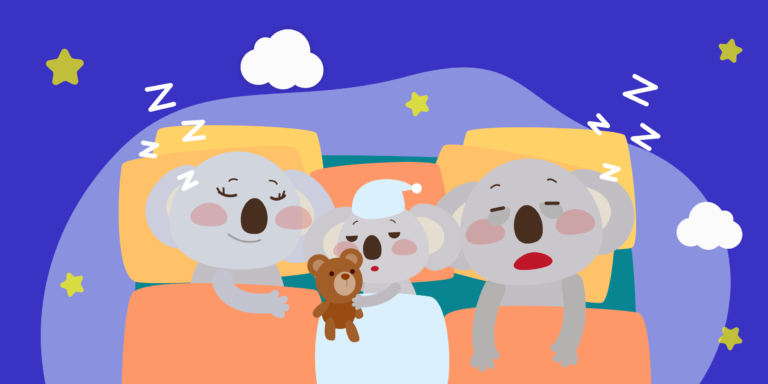Noticing Sleep Apnea in Children
It is common for children to exhibit behavioral problems at school and receive a diagnosis of ADHD. However, it could oftentimes be a misdiagnosis, and the actual issue might be that the children are suffering from sleep apnea. Pediatric sleep apnea is a sleep disorder that causes interruptions in children’s breathing during sleep, leading to poor sleep quality and inadequate rest at night.
It is common for parents to initially overlook their children’s sleep apnea. According to a study conducted by the American Osteopathic Association, as many as 15% of children may suffer from sleep apnea, with the majority, 90%, going undiagnosed. The reason behind this undiagnosed sleep apnea in children lies in the similarity between the symptoms of sleep apnea and ADHD. Consequently, many children are diagnosed with ADHD despite the fact that their behavioral issues may stem from inadequate sleep at night.
When schools or daycare centers report concentration difficulties or academic setbacks in children, it is important for parents to avoid rushing to an ADHD diagnosis. Considering the possibility of poor sleep quality causing these symptoms, a thorough evaluation for sleep apnea provides a more appropriate approach to diagnose and address the underlying issues, leading to effective treatment and overall improvement in children’s well-being.
Should parents be concerned about the effects of sleep apnea on their children?
The diagnosis of sleep apnea in children necessitates vigilant attention from parents, particularly when early signs are observed, as the long-term and potentially fatal consequences of untreated sleep apnea can manifest. Untreated sleep apnea during childhood can significantly impact developmental milestones and give rise to various health complications in adulthood.
Long-term ramifications of pediatric sleep apnea include the following:
- Delayed growth compared to peers: The disruption of the sleep cycle and reduced deep sleep impede the release of human growth hormone (HGH) during sleep, which could result in inadequate weight gain or even weight loss. Additionally, parents may observe developmental delays in milestones such as crawling, sitting, talking, babbling, or walking in affected toddlers.
- Potential ADHD Misdiagnosis in Children: Research suggests that 95% of patients with obstructive sleep apnea (OSA) exhibit attention span issues, a common symptom of ADHD in children (Youseff et al., 2011). Consequently, children with sleep apnea often face misdiagnosis with ADHD due to shared attention and behavioral problems. These behavioral issues, such as poor academic performance and difficulty concentrating, are primarily caused by insufficient sleep rather than ADHD. The overlapping symptoms between sleep apnea and ADHD contribute to the misdiagnosis.
- Enlarged facial structure: In children with sleep apnea, reduced nasal flow and oxygen deprivation often result in mouth breathing, which can lead to retrognathia, a condition where the lower jaw is positioned further back than the upper jaw. Consequently, the airway becomes narrower, exacerbating sleep apnea symptoms.
Mouth breathing also contributes to oral health issues in children, including gum disease, dental caries, and periodontitis.
- Development of heart problems: Children with sleep apnea often experience unstable blood pressure patterns during sleep and smaller drops compared to those without sleep apnea. Without blood pressure decreasing adequately during sleep, the risk of cardiovascular events increases.
Even mild sleep apnea in children, characterized by a low apnea-hypopnea index (AHI), elevates the risk of developing metabolic syndrome, which heightens the likelihood of heart disease, strokes, and type 2 diabetes. It also contributes to elevated insulin and triglyceride levels, both of which are associated with increased blood pressure. Additionally, it places children at a higher risk of pulmonary hypertension (American Heart Association News).
Children’s Sleep Apnea Diagnosis
Pediatric sleep apnea diagnosis can be achieved using one of two methods: polysomnography (PSG) and home sleep test (HST).
Polysomnography (PSG) test for Children
Polysomnography (PSG), the primary diagnostic test employed by sleep physicians, is widely utilized to identify various sleep disorders, including pediatric sleep apnea. Conducted overnight in a sleep clinic, this test necessitates minimal preparation prior to the child’s sleep study. Preparation guidelines include:
- Maintaining a regular sleep routine the night before the test
- Avoiding consumption of caffeinated foods and beverages (e.g., chocolate, soda, tea, coffee)
- Refraining from napping on the day of the sleep study
Children may continue taking their usual medications during the day. It is strongly recommended to arrive at the sleep center at least two hours before the child’s typical bedtime, or as instructed by the physician, to allow sufficient time for test preparation.
Despite initial concerns that PSG may evoke due to the attachment of wires to various parts of the child’s body throughout the night, these wires are entirely safe and solely connected to monitors that record sleep patterns. In some sleep clinics, parents have the option to accompany their children during the overnight stay and share the same sleeping space to enhance the child’s sense of security during the test.
Home Sleep Test (HST) for Children
PranaQ offers an alternative to the traditional PSG test with our simple and versatile home sleep test. With our wireless and portable device, parents can easily assist their child in diagnosing sleep apnea from the comfort of their own bed.
PranaQ’s home sleep test, TipTraQ, eliminates the need for wires, allowing children to sleep undisturbed. This test also provides continuous monitoring of children’s sleep over multiple days, ensuring accurate results for sleep apnea diagnosis in children.
To obtain the home sleep test (HST), parents can request it at a sleep clinic or acquire it through a certified medical retailer. Simplifying the diagnostic process, TipTraQ empowers parents to take a proactive approach to their children’s sleep health.
Next Steps Following Children’s Sleep Apnea Diagnosis
Interpreting sleep test results can be overwhelming, especially for first-time parents unfamiliar with sleep apnea. Fret not! PranaQ is here to provide comprehensive guidance to help you navigate the process of studying your child’s sleep apnea diagnosis and to help you choose the most suitable treatment for your child.
1. Consult with a sleep doctor for alleviating children's sleep apnea symptoms
While the diagnosis of sleep apnea in children may seem daunting, it’s important not to jump to conclusions! Take the time to understand the severity of your child’s sleep apnea, whether it’s mild, moderate, or severe, and the symptoms they may experience.
As you gather information about the possible effects of pediatric sleep apnea, take notes and have open discussions with your doctor about how these could impact your child. Ask about different treatment options and, if surgery is recommended, don’t hesitate to seek a second opinion from ENT specialists or pediatricians.
2. Choosing the right treatment for children's sleep apnea
A. Tonsil and Adenoid Removal Surgery (Tonsillectomy and Adenoidectomy/ Adenotonsillectomy)
Surgical removal of the tonsils or adenoids is a common and effective treatment for moderate to severe pediatric OSA. Enlarged tonsils or adenoids are often the cause of sleep apnea symptoms in otherwise healthy, non-obese children. To confirm this, a nasopharyngoscopy may be performed, where a flexible viewing tube is inserted through the nose to examine the back of the nose and throat. This procedure is typically carried out following a diagnosis from a home sleep test or PSG.
Studies indicate a success rate of up to 80% for children who undergo this surgery, depending on the severity of their sleep apnea. It has also been observed that children experience improved sleep and a higher quality of life after the surgery.
B. Nasal Spray or Allergy Medication
In some cases, enlarged tonsils may be due to allergies. It is advisable to explore non-surgical options first, such as obtaining a prescription for nasal sprays or oral allergy medications such as antihistamines, before considering surgery.
C. CPAP (continuous positive airway pressure) or BiPAP (bi-level positive airway pressure)
Another common treatment option for pediatric OSA is the use of CPAP or BiPAP machines. These devices deliver positive pressure to the airway through a mask worn by the child during sleep, effectively keeping the airway open and allowing normal breathing without the need for surgery.
It is important to note that using CPAP or BiPAP requires consistent daily use, which can initially feel claustrophobic for children. Adjusting to the device may be challenging, and parents may need to provide extra support to help their child adapt. However, studies have shown that once treatment with CPAP or BiPAP begins, it proves effective in managing pediatric sleep apnea.
3. Natural remedies for sleep apnea in children
Not all children are born with sleep apnea; it can develop due to certain health conditions or weight gain. Research indicates that 60% of obese children experience childhood OSA, suggesting that symptoms may improve with weight loss.
In some cases, lifestyle modifications can help avoid surgery or the use of CPAP/BiPAP. Regular exercise and a healthy diet can have a positive impact on children’s sleep apnea and overall well-being. Creating a conducive sleep environment can also improve their sleep quality.
In other cases, positional therapy, such as training children to sleep on their sides instead of their backs, may reduce sleep apnea symptoms as well.
However, it is important to use natural remedies under the guidance and recommendations of sleep physicians. If severe symptoms persist, long-term treatments like surgery or CPAP should be considered.
During consultations with a sleep doctor, they may recommend tonsil or adenoid removal if enlarged tonsils are found. Before deciding on any treatment, it is essential to thoroughly understand the available options to select the most suitable approach for your child’s sleep apnea.
Understanding Sleep Apnea in Children: A Positive Approach
Parents who may have concerns about their children being diagnosed with sleep apnea can find reassurance in the benefits of early detection. Early diagnosis of pediatric sleep apnea is not only safe but also allows for prompt and effective treatment options to be implemented.
With a range of treatment choices available, parents can be relieved of worries about sleep apnea affecting their children’s sleep quality and daily functioning. Effective treatment leads to improved sleep, alleviation of behavioral issues, and enhanced overall health for children.
Learn more about TipTraQ to help your child conduct a home sleep test today!
References:
- https://www.heart.org/en/news/2021/08/18/kids-who-snore-could-be-at-risk-for-blood-pressure-heart-problems
- https://kidshealth.org/en/parents/sleep-study.html
- https://medicalxpress.com/news/2019-02-percent-children-apnea-undiagnosed.html
- https://www.ncbi.nlm.nih.gov/pmc/articles/PMC6411169/
- https://www.msdmanuals.com/home/children-s-health-issues/ear-nose-and-throat-disorders-in-children/







